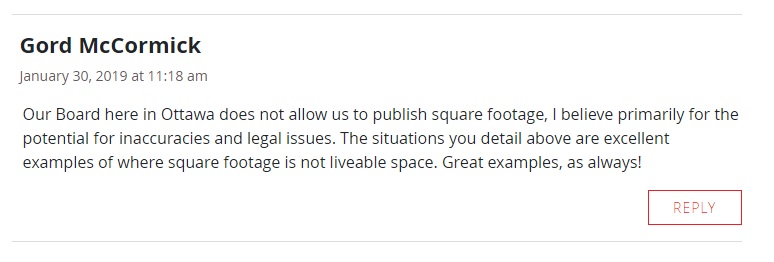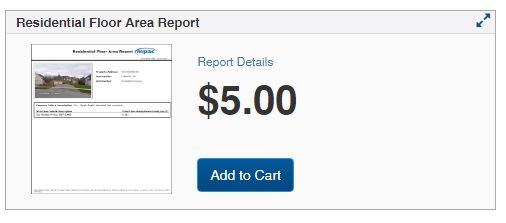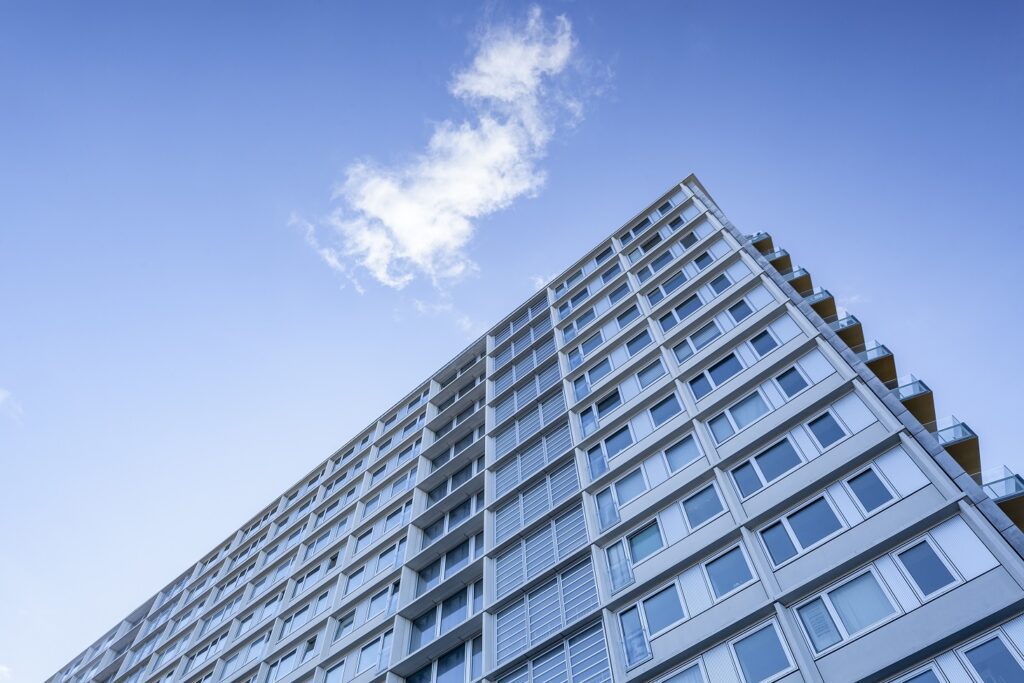This makes a great follow-up to Wednesday’s blog post, “Random Thoughts About Square Footage.”
There was a lot of conversation in the comments about how to calculate square footage, what standards to use, how developers make the calculations, what the difference between buildable and usable square footage is, and so on.
For a would-be condo buyer, this could be quite confusing.
But in my mind, it’s more than confusing; it’s downright scary.
When you consider that we pay for condos based on the square footage, not knowing the square footage, is a scary proposition.
Imagine if this were the case with other goods and services? Imagine if you had to purchase a bar of gold without weighing it? At $1,300 per ounce, wouldn’t you want to know if that bar weighted eight pounds or nine pounds?
To think that we value real estate based on a standard that we have no idea how to calculate is absolutely scary.
And as a reader pointed out on Wednesday, organized real estate is doing nothing to help:
Well isn’t that great.
This reeks of, “We’re afraid of failing, so we just won’t try.”
Or the classic Ned Flanders line, “We’ve tried nothing, and we’re all out of ideas!”
I understand the argument that you don’t want to provide a platform for constant litigation, but not looking for a solution is a cop-out.
The idea that publishing square footage is not made mandatory, I understand from a potential litigation perspective. But to basically ban agents from publishing square footage? That’s pathetic.
What’s next? What about a bedroom that might not be deemed a bedroom by all, because it doesn’t have a window, or a closet, or a door. Why not ban agents from specifying how many bedrooms there are?
As an industry, we have to do better than this. We have to raise our standards, and provide the consumer with better, more complete, and more accurate data so that they can make an informed purchase decision.
I have long maintained that TREB should make square footage mandatory, and the simple way to do that would be to get together with MPAC and work out a deal so that we have access to the square footage reports.
For those of you that don’t know (and this includes many Realtors…) MPAC has a slew of real estate related products available, customized to each property. And by “each property” I mean every property, since MPAC is linked to every single listing on MLS, current or past, and has an easy-to-use interface for those properties not appearing on MLS.
For example, I just looked up a newly-listed condo, and if you click “Store,” you see the following:
Right there, you’ve got twelve products that you may, or may not, find helpful with respect to your property search, comparative market analysis, or upcoming listing.
These are tools that Realtors have at their disposal for every property out there, be it house or condo, and these are far from cost prohibitive. Then again, if agents balk at paying $400 for a fantastic photographer to help advertise their $600,000 condo listing, then maybe $6.00 for a building permit report is a bit steep.
But the one product that every Realtor should be familiar with is this one:
The Residential Floor Area Report contains a square footage amount, on which MPAC presumably bases taxation.
This square footage, again – presumably, would be from a source deemed accurate, likely from the builder.
Having purchased about a thousand of these reports over the years, I can personally attest to the fact that they almost always match any available floor plan.
So it is my contention that the Toronto Real Estate Board should, at the earliest possible opportunity, make the inclusion of an MPAC Residential Floor Area Report mandatory for all condominium listings, and failure to provide the square footage and/or the document shall result in an error message when one tries to submit the listing to MLS. That’s the case when you don’t fill in the taxes; you can’t submit the listing. Same goes for any mandatory field – you get an error message in RED. Of course, you can put “$0” for taxes, but that’s not the point.
The point is, if we, as sales professionals, want to do our job effectively and to our fullest capability, we will find a way to provide consumers with this information.
So where does a person find square footage for a condo, in lieu of an MLS listing?
Here are the most effective ways:
1) MPAC
As described above, this is an option available to Realtors for $5.00 per property, and I believe the public can open an account and gain access as well.
2) ONLINE FLOOR PLANS
As a client once asked me, “How is your Google-Fu?”
If you’re willing to put the time and effort into it, you can probably find any floor plan from a condo in the past ten years. You just need patience.
I have complied a massive database of floor plans on my laptop, for thousands of units in hundreds of buildings. Every time I see a new floor plan, whether it’s attached to an MLS listing, or even a soft copy at a condo I’m visiting, I file it away.
There are a lot of real estate agent websites out there that have floor plans for newer buildings. I don’t feel like plugging those agents here and now, but let’s just say they’re easy to find.
There are also a lot of websites that have the word “floor plan” in the body of a web-page, whether visible or hidden, and that means that hundreds of clickable search results on Google will return zero actual useful information.
A colleague of mine at Property.ca told me once that his goal was to accumulate the floor plan for every single unit in the city of Toronto. Quite the endeavour! Condos.ca was, and still is, and industry leader in Toronto condominium data, but a database of floor plans would be something else altogether. I told him that I would gladly pay an annual fee for access to a database, as would many agents, I’m sure. Then again, most agents won’t pay $5 for the floor plan from MPAC for a property they’re listing, and being paid $10K, $15K, $20K or more to sell, so perhaps my suggesting that floor plan database subscriptions would go through the roof is wishful thinking.
3) PAST LISTINGS
In many condos, the square footage for Unit #1101 is the same as Unit #1201, and the same as Unit #1301, and so on.
Again, with some time and effort, this is an easy search through the archives of MLS.
Because most agents don’t include the actual square footage in listings (I would estimate less than 20% of historical listings have an actual square footage), this endeavour can be painstaking, but it often bears fruit.
When I’m doing a Comparative Market Analysis for a condo, I’ll include the exact square footage for every comparable unit. When I see other agents give a “range,” like 500-599, I laugh. Imagine that gold bar, weighing somewhere between 8 and 9 pounds, and being expected to pay $1,300 per ounce.
To find the square footage of every unit, the first place I go is to the MLS archives. First, I look up the history of that unit, and if the building is old enough and the unit has been sold before, I might find it. Then, I’ll go to the archives for all the units with that model number, and 95% of the time, I’ll find the square footage. Of course, I have a rule that I need triple-confirmation, otherwise it doesn’t fly. If 1201, 1301, and 1401 are all said to be 542 square feet via past MLS listings, then we’re good.
4) MAINTENANCE FEE MATH
This is a very inexact science, but it can get you anywhere from 90% to 100% accuracy.
In virtually every building in the downtown core, maintenance fees are apportioned by square footage.
So if you can solve for “X,” you can figure out the fees.
Keep in mind that basic maintenance fees, per unit, do not include a locker or a parking space. Those are separate, and are lumped in with the overall fees on MLS.
So if Unit #1201, with parking and locker, has fees of $451.87, and is measured at 652 square feet as per MPAC, floor plan, or other source, then you know the fees are 69.3 cents per square foot. And you’re looking at Unit #2707, which also has parking and locker, and shows as having fees of $655.52 on MLS. Get your friend from NASA to work this complicated mathematical dilemma, and voila – the unit is approximately 946 square feet.
Just remember, you need to compare apples to apples. So if you’re looking at a unit with locker, and no parking, then you need the square footage of another condo with locker, and no parking. And, since we know maintenance fees usually increase one out of every two years on average, then you need a comparable sale that’s very recent.
5) PROPERTY MANAGEMENT
Are you good on the phone?
Suave, charismatic, and convincing?
Property management has the square footage for every condo in the building, so why not call them up and just ask?
They don’t have to give it to you, of course. And human nature is to question a person’s agenda and integrity. Just say, “I’m looking at buying Unit #XXX that’s currently listed for sale, and there’s no square footage on the listing. It just says 900-999, and I’m trying to figure out the exact square footage.” Maybe give them my “bar of gold” anecdote, and the person on the other end of the line will see the logic, and respond in kind.
Now this might not work if you needed the square footage of sixteen units for a CMA that you’re doing, but if you’re just a prospective buyer looking for one unit’s square footage, I see no reason why the property manager wouldn’t help.
–
I’m not a “car guy,” but I’ll give this analogy a shot.
There are different types of engines, right? V6 and V8? I’m assuming that the difference between those two is about……..V2, or something?
Right. Okay. So there’s also litres, horsepower, and torque, and I won’t even guess at things like HEMI and turbochargers. I just hear the words on television ads.
So if you’re a car-buyer, do you want to know the size of the engine? Does the engine in a Lexus IS 250 differ from that of a Lexus ES 350? If so, would you want to know, or just guess?
What if the windows on the car were tinted, and you couldn’t see inside? What if you had to guess whether the seats were leather or cloth? What if you didn’t know whether there was a navigation system in place?
The fact that we as Realtors are not required to provide exact square footage is mind-boggling, and I’m downright embarrassed as an agent. Considering the “price per square foot” metric is the most commonly-used evaluator of condominiums, it’s puzzling as to why we haven’t made this mandatory as of yet.
Fear is not the best motivator. If the folks at TREB are afraid of being sued, then use those same lawyers who say, “There’s no upside to this, just leave square footage out,” to draft some legalese that covers themselves, and agents if need be, in the event of a discrepancy.
We could avoid all of this if TREB just used some of their accumulated war-chest (from their Competition Bureau fight…) to work out a deal with MPAC, but I didn’t intend to turn this blog post into a TREB-bashing, so I’m going to stop here.
One final thought about square footage sources, for both buyers and sellers: what’s the deal with virtual tours?
If you’re using a virtual tour’s floor plan on a listing for the square footage source, should you get further verification?
Does the virtual tour usually end up higher or lower than MPAC? That’s tough to say. I’ve seen it both ways, to be honest.
And that begs the question: what source do I use when I have two different numbers?
Truthfully, folks, I leave that up to the seller. If MPAC says the unit is 635 square feet, but the floor plan shows 646, I will ask the seller what they want to use. It’s up to them, and that’s not me passing the buck; it’s me giving my client options as to how they want their condo marketed. I would suggest they use MPAC, but MPAC has been wrong before, and I’ve seen first-hand instances of MPAC being lower than an in-hand floor plan from my seller, albeit maybe 2-3 times, but it’s happened.
I’m not God, and I’m not the authority on this. I leave this decision to my sellers, and I would advise all listing agents to do the same.
As a buyer, if you see square footage on a virtual tour floor plan, I can tell you that in my experience, it’s lower than the MPAC square footage about 70% of the time.
But then again, two sources are always better than one, so when in doubt, just go for a deeper dive!
Have a great weekend, everybody!



































Carl
at 7:29 am
Agreed. The square footage should be a mandatory part of listings.
If you are not sure that the number you have is absolutely correct to the last decimal digit and don’t want to be sued, just list what you think is 608 sf as “more than 600 sf”.
It is now a common practice to list the same room twice, as the living room and the dining room. Every time I see that, I say to myself “so the listing agent is trying to fool me — what else will (s)he lie about?”.
Francesca
at 7:31 am
I always found it odd how in Ontario very few condo and house listings offer square footage information. I would think this is something any potential buyer would want to know before deciding to know whether to bother viewing a property or not. Layout and useable space can be more important than actual sq footage especially when it comes to smaller spaces but that still doesn’t mean precise sq footage shouldn’t be given. Look up listings in Vancouver and Montreal and pretty much all of them include exact sq footage. Even in Italy where I’m from apartments are marketed with exact sq footage. I feel that here it’s almost like realtors and sellers are trying to hide this information from sellers to possibly justify a higher than average price and hope that buyers are gullible enough to fall for view, renovations, location etc and look past at how small and expensive a property actually is. I for one would be all for it being mandatory to find out and publish exact sq footage rather than the range that currently appears on realtor.ca.
JG
at 8:43 am
https://business.financialpost.com/real-estate/toronto-new-home-sales-plunge-as-buyers-balk-at-spiraling-prices
Just a couple of weeks ago, my friend Appriaser was pumping 416 condo. I think it’s pretty stupid to buy an investment condo right now after the run up last 2-3 years. Of course people who are holding the bag want more to pile in for the sake of self interest.
I’m willing to predict 416 condo will decline in price in 2019.
Appraiser
at 9:09 am
I guess you missed this part of the article “… condo prices surged 11 per cent to $796,815, according to BILD’s report.”
The rest of the piece is made of of conjecture as to future prices, and cherry-picked stats. Nothing new here, Just more scary headlines / clickbait to feed the bears.
Appraiser
at 9:24 am
P.S. “A reminder that the level of completed and unsold developer-owned condo inventory is at the lowest level in over 30 years.”
~Ben Myers response to the report via Twitter.
Appraiser
at 9:27 am
P.P.S.
“The removal of rental control on new buildings and the spike in Toronto rental rates will keep investors interested” ~Ben Myers.
Not Harold
at 11:24 am
Predicting the future is hard.
10% annual increases are high and seem frothy, but can be sustained for much longer than expected – see Toronto real estate for the last 15 years.
30% is absolutely a bubble, outside of very high inflation.
What you can have is a secular revaluation. A less loved asset becomes more valuable as demand changes. This can push prices up for a long time, while seeming like a bubble if you don’t understand or accept the changes in demand. Can also happen the other way.
Why would you want to be in a 416 condo, especially a downtown/midtown condo? The affordable suburban edge is pretty far out, and in most cases you only see real price drops on the other side of the Greenbelt. Changes in mortgage availability are taking people out of the market for gentrifying houses and pushing them back into condos. Commute times and reliability are far superior when you’re within walking distance of very many offices or are a reasonable cab away during failures in the case of Bloor/St Clair. Large numbers of high paying jobs are moving downtown from the suburbs. Schools in condo areas are going to get dramatically better as more people stay in them, reducing the need to move.
So there could be good reasons for re-evaluating the attractiveness of condos in the core vis a vis 905 condos (or even outer 416 condos aka around kipling station, upper-upper-upper beaches, sheppard…), 905 houses, and non-prime 416 houses.
Now throw in that the US and Canada look to have stopped rate hikes.
Could everything go to hell tomorrow? Absolutely. TD might be discovered to have been falsifying their books for 20 years, or China nukes Vancouver, or Doug Ford triples tax rates only on housing in the Old City of Toronto.
But do try to assess your prejudices and whether your reasons for believing 416 condos will fall in price take into account/are enough to overwhelm secular positive trends.
Professional Shanker
at 1:55 pm
My gut tells me this isn’t a secular revaluation of condos vs. houses, but rather simply speculator money moving from 905 homes (2014 to 2017) to 416 condos (2016 to 2019). Condo prices have taken off recently in a similar fashion to how detached did earlier, mostly based on expected price appreciation/stress test.
All the reasons you provide on city/core living have been there for the past 3 decades – nothing has changed in the GTA. That said you points are valid and well thought out!
The prices of the GTA housing stock are relative to one another over a long term period of time. It is not likely we will see a 905 home/non-prime 416 home stagnant in price while condo appreciation continues at a clip of 5 to 10%/year for a multi year period.
Appraiser
at 7:15 pm
“For every complex problem there is an answer that is clear, simple, and wrong.”
~ H.L. Mencken
Your “gut feeling” and simplistic theory is relevant because…?
Professional Shanker
at 8:40 pm
If you can’t explain it simply, you don’t understand it well enough ~AE
Either 416 condos reduce in value or non-prime houses increase in value, pick your side, the correlation in the GTA will hold up in the medium to long term.
Not Harold
at 1:02 pm
Some of the benefits to core have been there for a while – Oakville has always been the same distance!
But we have seen substantial changes in the last 2-3 years. Mortgage stress test being one, move of the affordable border from inside to outside greenbelt, and move of large suburban employers to downtown core. Not to mention the ever improving quality of life in the core.
The Kings was a planning project in 96 and King West between Spadina and Bathurst was VERY different. The Wheat Sheaf was still there, but they had absolutely no problem hosting 80 17-20 year olds for a party in late August. Not exactly a crowd that would be acceptable now.
Hell when Brant House first opened in 04 King West was pretty gritty. Just like how Queen West West wasn’t ideal when the Drake opened earlier that year.
The financial core, King West, and King East are getting better every year but there’s still issues. Schools are a big one, as are services outside of 9-5. Every building adds more potential customers and modern retail spaces while taking out a parking lot.
Just like a subdivision under construction won’t have the same value when you’re still faced with 3 years of muddy roads, dirt front lawns, and a 5+ year weight for the neighbourhood school to be built. But when everything is done, or maybe a year or two after, you’ll really start to see appreciation.
There’s still a ways to go before the core is fully mature. The city place schools are supposed to open this year and we’ll need a few years to see how they turn out. But we have a range of product from tiny 1 beds to 2 ultra luxe condo towers and an understanding that it’s not the forbidding tundra of empty warehouses and parking lots that it used to be.
Appraiser
at 9:02 am
Great post David. A few years ago the lenders that we deal with including BMO, CIBC, TD and National Bank, began requiring that the square footage of the comparables utilized in every appraisal report be included. The subject property has to be measured manually, unless a floor plan is available.
We worked a deal with MPAC to buy the reports for $2 each. I go through between 100 – 200 per month. I’m sure TREB could work an even better deal, considering that there are at least 100 realtors for every appraiser.
Be aware that MPAC is not always 100% correct, but pretty darn close. Making it mandatory on every listing would be fantastic for everyone, and would also save me several hundred dollars a month.
IanC
at 9:44 am
You’ve got something there, Dave.
Make it mandatory to publish
a) The Maintenance fee rate on the building (per square foot)
b) The Total Maintenance fee breakdown (unit, parking, locker)
Of course some buildings (Radio City?) don’t base 100% of their unit maintenance fees on square feet alone, but it’s a start !
Sirgruper
at 4:15 pm
David
Enjoyed your blog from afar for quite a while. Good post. Love the Simpson’s reference as its one of my favourite quotes, but its actually Ned’s Dad who says the quote about little Ned acting up.
MPAC is certainly better than no information but they are often wrong especially in commercial and industrial properties. Their work there can be shoddily diddly oddily 🙂
Thanks again for the blog.
Appraiser
at 7:09 pm
“Beer. The cause of and the solution to, all of life’s problems.
~Homer Simpson
Joel
at 12:54 pm
Asa mortgage broker I wish that every listing had square footage, property tax and year built. The amount of listings that have none of these is baffling to me.
The commission on the average $500,000 condo is enough to spend 10 minutes and $10 to figure these out and put them on the listing so that buyers are aware.
Sal Jain
at 2:58 pm
Hello, I’ve tried to get the entire floorplans for an older project in Downtown Toronto and the developer said they don’t have it. I’ve tried everywhere from websites to asking property management. Does anyone have recommendations on how to access floorplans for an older project or know anyone out there that may have older floor plans saved somewhere??
The author of this blog mentions they have a large database. Any suggestions on obtaining older floor plans for older projects would be greatly appreciated. I will definitely start creating a database for these going forward because it’s proving to be difficult now!
Adrian Trott
at 2:38 pm
Forget MPAC; real estate agents need to be hiring a company to take accurate measurements and creating floorplans. Agents who aren’t adding this, and other services, to their offering, are going to be eaten alive by those who do.
Lucky mar
at 7:29 pm
Regarding the topic of square footage of a condo unit I would like to say that publishing the square footage may not be accurate. I have the real estate listing for my unit when I bought it which states all measurements of each room and that it is a 3 bedroom. When I had an agent come to my unit for possible sale, I was told those measurements did not add up to the square footage stated. If an ad says 1000 sq. ft. I believe that and don’t add it all to see if it adds up. Maybe I should have but this is my first condo and I didn’t know what I was doing at the time. Now if I want to sell do I go by the agents info that my sq. footage is less and I don’t have 3 Bdrm but 2 +. What is my condo fees based on and management is not very approachable or cooperative and lies continually to me. How do I figure this out. Can I go to the city and find the original paperwork to state the sq ft and if 2+ or 3 bdrm. How do I know if my parking spot or locker room is original. They could have been changed over the years. I don’t trust anything I am told now. Where do I go to get accurate info.